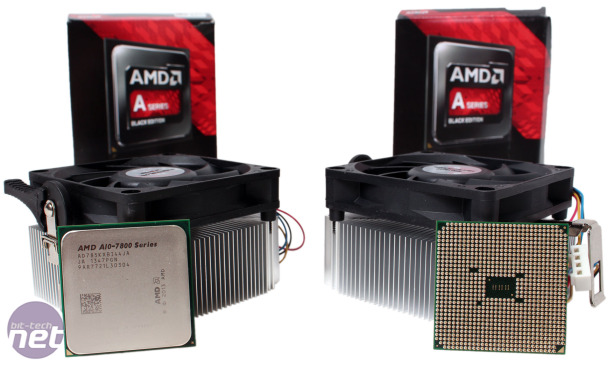
AMD A10-7850K and A10-7700K (Kaveri) Reviews
Manufacturer: AMDA10-7850K price (as reviewed): £126 (inc VAT)
A10-7700K price (as reviewed): £110 (inc VAT)
Thanks go out to Scan for supplying us with samples of both the A10-7850K and A10-7700K
Our first exposure to AMD's new Kaveri APUs came, rather peculiarly, in the form of the as yet unreleased A8-7600, as the top of the range A10 samples were in short supply. However, we've now got hold of both top end parts, the A10-7850K and the A10-7700K, so it's time to put them to the test. The -K suffix denotes that both chips have unlocked multipliers, so we'll be overclocking them as well (not forgetting that chips lacking this feature can still be overclocked via some BCLK tinkering).
Our A8-7600 review has tonnes of detail about Kaveri, so we're only glossing over the more relevant factors here. Nevertheless, with Kaveri, AMD has moved its desktop APUs from a 32nm process to 28nm. Kaveri also brings with it the new FM2+ platform and accompanying A88X and A78 chipsets. These are backwards compatible with FM2 chips, but Kaveri APUs can only be used in FM2+ socket motherboards. The Kaveri chip itself is 245mm2 and comprises 2.41 billion transistors.
AMD has stuck with its x86 Bulldozer architecture but has made some optimisations for this third iteration, called Steamroller. The main changes include a doubling up of the decode hardware at the front end and increases to the L1 instruction cache and branch target buffer. AMD is also utilising the latest revision of its GCN architecture for the GPU side, with up to eight compute units in a single chip. This brings with it support for Mantle (assuming it does actually arrive at some point), and AMD has also included its TrueAudio DSP for dedicated onboard sound processing.
The most significant architectural upgrade, however, is the use of HSA (heterogeneous system architecture), a hardware level solution that enables two or more processing elements (in this case the CPU and GPU) to communicate with a lot less overhead than traditional methods. One way this is achieved is through hUMA (heterogeneous Uniform Memory Access) whereby both elements have equal and shared access to the system memory, reducing the need to copy data in and out of two separate virtual buffers.
Another way is hQ (heterogeneous Queueing), which means both the CPU and GPU can dispatch tasks to each other from within their own kernels, thus bypassing a number of overheads. As ever, programmers will need to write code in order to take advantage of this, but these features make Kaveri the world's first OpenCL 2.0 compatible chip, and AMD is keen to assert that the benefits will be widely felt in the future.
| APU Model | A10-7850K | A10-7700K | A8-7600 |
| Compute Cores | 12 (4 CPU / 8 GPU) | 10 (4 CPU / 6GPU) | 10 (4 CPU / 6GPU) |
| TDP | 95W | 95W | 65W / 45W |
| CPU Base Clock | 3.7GHz | 3.4GHz | 3.3GHz / 3.1GHz |
| CPU Turbo Clock | 4.0Ghz | 3.8GHz | 3.8GHz / 3.3GHz |
| Total L2 Cache | 4MB | 4MB | 4MB |
| GPU Clock | 720MHz | 720MHz | 720MHz |
| Max DDR3 Speed | 2,133MHz | 2,133MHz | 2,133MHz |
| Unlocked Multiplier | Yes | Yes | No |
| RRP | £126 | £110 | $119 (£90~£95?) |
Looking at the specifications, the A10-7700K emerges as quite an odd chip, in that it's barely different to the A8-7600. They share the same CPU and GPU hardware, and, with the A8-7600 in its 65W configuration, almost identical clock speeds, with the A10-7700K's 100MHz higher base clock being the only difference. Performance margins between these will thus be small, especially in GPU-limited tasks, but the 95W TDP of the more expensive chip should allow it to boost more consistently. It also has an unlocked multiplier, and you can see how we got on with that over the page.
The flagship chip, the A10-7850K, differs itself most obviously by its two extra compute units in the GPU, giving it a total of 512 stream processors compared to 384 in the parts below (although these aren't clocked any higher). Its clock speeds are also the highest of the bunch, but these are still less than the A10-6800K it replaces. This is mainly a result of the move to 28nm, and it should be balanced out by Kaveri's higher (on average) instructions per clock.
Looking at pricing, the £126 A10-7850K is more expensive than any Core i3 part, while the A10-7700K comes in just between the Core i3-4330 and Core i3-4340. The A10-7700K will also need to be pretty impressive to justify its price premium over the A8-7600, given the similarities between them.

MSI MPG Velox 100R Chassis Review
October 14 2021 | 15:04









Want to comment? Please log in.